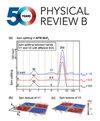Evolution of the optically detected magnetic resonance spectra of divacancies in 4 H -SiC from liquid-helium to room temperature
IF 3.7
2区 物理与天体物理
Q1 Physics and Astronomy
引用次数: 0
Abstract
The divacancies in 4H-SiC attract significant attention for use as qubits owing to their spin and photoluminescence (PL) properties and near telecom PL emission. Nevertheless, there exist some ambiguities in the interpretation of their optically detected magnetic resonance (ODMR) spectra, especially at elevated temperatures. In this study, we investigate the divacancy configurations PL1–PL7 using PL and ODMR. We record the full temperature dependence between liquid-helium temperature (3.8 K) and room temperature (295 K), obtained with two different laser energies and different laser polarizations. We also present PL data recorded simultaneously with the ODMR. Our study allows us to continuously follow the evolution of all divacancy configurations in ODMR with temperature, even though their signature is not distinguishable in PL at elevated temperatures. We identify all lines in the room-temperature ODMR spectrum and show that a hypothetical defect PL7, assumed in earlier work to stem from another divacancy configuration, does not exist and its ODMR signal at room temperature is fully explained with PL4. We also provide direct PL evidence on the spatial distribution of PL5, PL6, and a new PL3a defect, showing their presence only close to the surface of the sample, thus corroborating their association with divacancies near stacking faults. We address also the role of the upconversion of the photoluminescence in the ODMR spectra observed at higher temperatures.求助全文
约1分钟内获得全文
求助全文
来源期刊

Physical Review B
物理-物理:凝聚态物理
CiteScore
6.70
自引率
32.40%
发文量
0
审稿时长
3.0 months
期刊介绍:
Physical Review B (PRB) is the world’s largest dedicated physics journal, publishing approximately 100 new, high-quality papers each week. The most highly cited journal in condensed matter physics, PRB provides outstanding depth and breadth of coverage, combined with unrivaled context and background for ongoing research by scientists worldwide.
PRB covers the full range of condensed matter, materials physics, and related subfields, including:
-Structure and phase transitions
-Ferroelectrics and multiferroics
-Disordered systems and alloys
-Magnetism
-Superconductivity
-Electronic structure, photonics, and metamaterials
-Semiconductors and mesoscopic systems
-Surfaces, nanoscience, and two-dimensional materials
-Topological states of matter
 求助内容:
求助内容: 应助结果提醒方式:
应助结果提醒方式:


